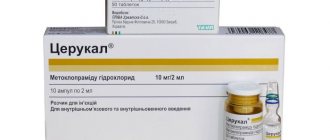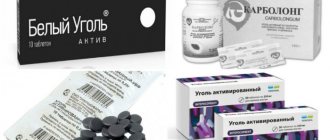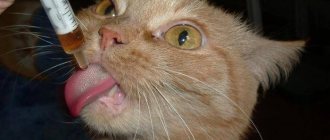In veterinary medicine, antihistamines are used for allergic reactions of various origins. Regardless of what caused the process, you can give Suprastin to your cat. This medicine effectively eliminates the effect of the allergen in both cats and other animals. It is important to choose the right dosage so that the use of this remedy brings relief to the animal and does not cause a number of complications.
In what cases is it used?
Cats have allergies to food, medications, household chemicals, dust, poplar fluff, ragweed, etc. Antiallergic drugs are prescribed. The mechanism of action of Suprastin is to block histamine receptors, which are involved in the occurrence of allergic reactions. The medication eliminates itching well, so if your cat is itching, then this medicine will help. It also has a calming effect, which makes it possible to give it to a cat in heat. In the treatment of certain diseases, it is prescribed in combination with other medications, which cause allergies in many.
To treat allergic reactions in a cat, in addition to Suprastin, a hypoallergenic diet is required.
Suprastin for cats in heat: is it possible?
The antihistamine does not interrupt estrus, but reduces the pain that accompanies it. Suprastin is indicated for a cat when she shows excessive aggression or excessive affection during estrus. The drug does not cause pregnancy failure. It should not be used without the approval of a veterinarian.
There are drugs that are safer for the health of cats that regulate sexual heat.
The optimal replacement for Suprastin during estrus is the following medications:
- Fitex;
- Stop Stress;
- Vetspokoin;
- Cat Baiyun.
How to give?
The drug, in tablet form, is given to the pet once a day, preferably at night due to its sedative effect.
"Suprastin" is used in tablets and injections. The dosage depends on the age and weight of the animal. A kitten and an adult cat weighing 2.5-3.5 kg are prescribed 1/6 of a tablet, from 3.5 to 6 kg - ¼. For animals that weigh more than 6 kg, the dose is based on ¼ tablet. by 5 kg. The medicine is used once a day, preferably at night, because it has a sedative effect. The course of treatment ranges from 3 to 7 days. The dosage of the solution for injection is calculated as follows: per 1 kg of body weight 2 mg of the substance. Injections are used for intramuscular administration, sometimes intravenous administration is allowed, but under the supervision of a veterinarian. You must follow the dose recommended by your doctor to avoid overdose. Suprastin tastes bitter, so there are tricks to give a cat such a drug without damaging its psyche. You can, of course, just put it on the root of the tongue, but your pet may not like it. It is recommended to crush the tablet into powder, mix with water and pour from a syringe. You can hide the medicine in a piece of your favorite delicacy, meat, cheese, bread. There is also the option of mixing crushed tablets into food. You need to give the injection after the furry has been mentally prepared and reward him with a treat for this.
Suprastin for a cat: dosage, how often
The drug is available in tablets or solutions for injection. Animal owners are not recommended to inject Suprastin on their own. It has been empirically established that 1/6 of a pill is recommended for animals weighing 3±0.5 kg, and ¼ pill once a day for cats heavier than 3.5 kg.
The medicine is bitter, so the owner has to resort to tricks - put a tasty morsel inside or grind it into powder and inject the suspension into the mouth with a syringe without a needle. The duration of the course of treatment is determined by the veterinarian.
If the itching cannot be relieved by using pills, an intramuscular injection is given. A medium-sized cat (4 kg) is given half an ampoule (0.5 ml). Animals weighing from 2.5 to 3.5 kg are injected with 0.2-0.4 ml. In severe situations, the veterinarian administers the drug intravenously, using a dosage of 2 mg (0.1 ml)/kg body weight.
Be sure to read:
Kotervin: instructions for use for cats, dosage, indications and contraindications, how to give
Form of release of the drug and composition
The product is available in two dosage forms:
- The tablets are white, with a slight grayish coating possible. On one side there is a mark, on the other there is an engraving in the form of the name of the drug. The tablets are produced in cardboard packs, each containing 2 blisters of 10 tablets. The product is also available in glass bottles with a rubber cap (20 tablets per jar).
- Ampoules of 1 ml, in one cardboard package – 5 pcs. The solution is colorless; upon opening, a slight characteristic odor is felt.
The main active ingredient of suprastin is chloropyramine hydrochloride, 25 mg in one tablet, 20 mg in an ampoule. The solution contains distilled water as an auxiliary component.
In addition to the main substance, the tablets contain: potato starch, 116 mg of lactose monohydrate, talc, sodium carboxymethyl starch (type A), gelatin and stearic acid.
Suprastin is available in tablets and ampoules for injection.
Suprastin for a cat in heat
The solution is colorless; upon opening, a slight characteristic odor is felt.
The main active ingredient of suprastin is chloropyramine hydrochloride, 25 mg in one tablet, 20 mg in an ampoule. The solution contains distilled water as an auxiliary component.
In addition to the main substance, the tablets contain: potato starch, 116 mg of lactose monohydrate, talc, sodium carboxymethyl starch (type A), gelatin and stearic acid.
Tablets are given in a certain dosage. Animals whose weight varies from 2.5 to 3.5 kg are given one sixth of the tablet; larger cats (from 3.5 to 6 kg) are given a quarter. The drug is fed to pets once a day.
Owners recommend resorting to some tricks when taking pills for animals:
- You can wrap a piece of medicine in something tasty, for example, a piece of sausage, sausage or meat. Some owners make a small ball out of bread crumb and put the required dose inside.
- The tablet needs to be crushed into powder, poured onto a spoon, then add a little water, mix and pour into the pet’s mouth at the root of the tongue. This procedure is best done with an assistant. Instead of a spoon, you can take a syringe without a needle.
- Some owners buy inexpensive drugs in capsules (for example, Loperamide), pour the contents out of the shell, place a piece of the tablet in it and feed it to the pet.
The dosage of the solution is calculated as follows: 2 mg per 1 kg of weight. A medium-sized cat weighing 4.5-5 kg is prescribed ½ ampoule of the medication; small animals are given 0.2-0.4 ml. Suprastin is administered strictly intramuscularly; in severe cases, intravenous administration is allowed, but only under the supervision of a veterinarian.
In the article I will talk about the drug Suprastin and how it is given to cats. I will describe the mechanism of action and composition. I will list the indications for the use of suprastin in cats and give the dosage. I'll tell you if there are analogues and what its cost is.
Suprastin (chloropyramine) is one of the most popular first-generation anti-allergy drugs in Russia. The medication effectively relieves itching, relieves spasms and swelling, and soothes.
Suprastin treats not only people, but also animals. It is quickly absorbed in the intestines, therefore it is one of the most effective allergy remedies.
The drug has long proven itself in veterinary medicine. If the case is urgent and there is a threat of anaphylactic shock, you can safely use suprastin for dogs.
When to use
Allergic attacks in animals are much more severe than in humans. If a person “gets off” with swelling of the mucous membrane, runny nose and sneezing, then pets’ paws will also swell. The dog constantly licks its limbs and scratches its skin, which leads to ulcers and non-healing dermatitis. For some breeds, an attack can be fatal.
Your dog may have an allergy if the following signs are observed:
- skin redness;
- itching;
- lacrimation;
- eczema of the outer ear;
- cough;
- nasal discharge;
- swelling;
- abnormal sweating;
- rashes in the armpits and on the stomach;
- unpleasant smell of wool;
- swelling of the limbs;
- hair loss;
- vomit;
- diarrhea.
Irritation is caused by odors from household chemicals, aerosols or perfumes. An attack is also possible when changing food, or being stung by a bee or mosquito. Giving Suprastin to a dog with allergies is necessary to quickly relieve the attack.
Veterinarians also prescribe this antihistamine in the following cases:
- Before deworming (especially breeds prone to drug intolerance).
- Before scheduled vaccinations and during drug therapy (to exclude anaphylactic shock).
- To relieve symptoms of neurodermatitis.
- For bronchial asthma.
- From seasonal hay fever.
- To eliminate Quincke's edema.
- In case of motion sickness on trains.
- Pregnant dogs with nausea.
- With motor excitement (suprastin has a slight sedative effect).
Suprastin is available in the form of tablets and ampoules (in the form of an injection solution). The main component is chloropyramine hydrochloride. in one tablet – 25 mg, in 1 ml of solution – 20 mg.
In addition to the main element, the ampoules contain water for injection. The tablet form includes excipients such as gelatin, stearic acid, starch, talc and lactose.
The medication is quickly absorbed by the intestines. The maximum concentration of the main substance in the blood is reached two hours after application. Chloropyramine hydrochloride penetrates into all organs, including the brain. The animal may experience a state of drowsiness and lethargy.
If the dog's condition is quite tolerable, tablets are usually prescribed. Relief occurs after 30 minutes, the effect lasts up to half a day.
If the allergic attack is acute and develops quickly, it is better to resort to injection. The injection is usually given in the hind leg or withers. The drug begins to act after 10 minutes, but the effect is shorter - up to 3 hours.
Suprastin is given to dogs during or after meals. Veterinarians usually combine both forms: they give an injection, and after some time they prescribe tablets. So the effect of the drug lasts for a day.
Dosage
According to the instructions, the daily dose for a dog in tablets is 2 mg per kilogram of weight. The dose must be divided into three doses.
To calculate the correct amount of the drug, you need to know the weight of the pet. If the dog is a small breed, it is recommended to give half a tablet. Medium-sized dogs – 1 tablet. For large breeds – one and a half or two.
The dose of intramuscular injection is calculated according to the same principle:
- small breeds – 0.5 ml;
- medium – 1 ml;
- large – 2 ml.
If the dog's weight is unknown and there is no way to find out, don't take the risk. It is better to reduce the dosage to avoid complications and unpleasant consequences.
Suprastin injection is carried out as follows:
- Wash your hands thoroughly.
- The medicine should not be cold.
- Draw the substance into the syringe and remove all bubbles.
- Hold your pet during the procedure so that he does not jerk during the injection.
- Slowly inject the solution intramuscularly.
- For toy breeds, an insulin syringe is suitable.
READ Puppy feeding regimen - tables, graphs and feeding ration
It is almost impossible to give an injection yourself. If you are not confident in your abilities and you do not have an assistant, it is better to use the tablet form of the drug. Suprastin is good for stopping an allergy attack. If the symptoms disappear after a single dose, there is no need to continue treatment. The duration of treatment depends on the severity of the disease. It is better to consult a veterinarian about this.
The bioavailability of suprastin in dogs is much lower than in humans, so there is less risk of side effects. Still, the medication can be quite difficult for dwarf pets to take. Veterinarians recommend second or third generation antihistamines for such dogs.
Puppies are given medicine only from the 30th day of life. The dosage is the same as for small breeds. If your dog is prone to allergies, it is better to consult a veterinarian before taking Suprastin.
Suprastin for dogs, pregnant or lactating, does not cause harm. But the dosage in this case should be minimal - 0.5 tablets. Each breed has its own characteristics. Therefore, consult your veterinarian before starting treatment.
For dogs with allergies, it is better to look for analogues.
Elderly age
It is better for elderly pets to abstain from suprastin, since the advanced age of dogs is one of the contraindications for taking this drug. If the body is weakened, the risk of side effects becomes higher. It's better to look for analogues.
Suprastin is quite effective when you need to quickly remove allergic symptoms. For the most part, the medicine is harmless and easily tolerated. But sometimes there may be unwanted side effects: anxiety, strange behavior and heart problems.
The risk of complications is higher if the dog’s body is weakened due to age or due to illness. In rare cases, a first-generation antihistamine may itself provoke new allergic reactions. In this case, treatment should be stopped immediately.
After a while the condition returns to normal.
Overdose
If suprastin is chosen to treat a dog, follow the dosage. Exceeding it increases the risk of negative reactions.
Signs of overdose:
- excessive physical activity;
- lack of coordination (it is difficult for the dog to stand on its paws);
- convulsions;
- dilated pupils;
- dry mouth;
- problems with urination;
- increased anxiety.
In such cases, it is necessary to perform a gastric lavage or give the pet a sorbent.
Contraindications
Suprastin is recognized as a fairly safe medicine. The main contraindications include:
- puppy age (up to 1 month);
- kidney disease (since it is this organ that removes the drug from the body);
- advanced age of the pet.
The medication is addictive, so long-term use is not recommended.
Analogs
There are four generations of antihistamine drugs. Depending on the dog's age, size, and health, your veterinarian may prescribe any of these.
First generation
These medications are easily absorbed and quickly relieve symptoms. Their action is relatively short-lived. Depending on the form of administration, the effect ends after 3-8 hours. Side effects include lethargy, drowsiness, and addiction. This group, along with suprastin, includes diphenhydramine, as well as the drugs Tavegil and Bravegil.
Second generation
The effect of the drugs is no longer as fast, but longer lasting. You can take one tablet per day. The effect lasts for another week after the end of treatment.
Antihistamines in this group do not have the side effects of first-generation drugs: they do not cause drowsiness or addiction. However, they also negatively affect the contractile function of the heart muscle.
These include: Zyrtec, Claritin, Lomilan.
These medications have all the advantages of the previous group, but do not affect the cardiovascular system. They can even treat elderly dogs. These are Telfast, Trexyl, Gismanal.
Corticosteroids
Overdose
In case of an overdose, a pet may lose its paws, so it is necessary to accurately calculate the dose of the drug. If Suprastin is prescribed to a cat with allergies, then the animal’s condition will be calm. He will sleep for a long time and walk lethargically. This should not alarm the owner. If the dosage is not calculated accurately, the cat’s paws will fail and she will not be able to stand on them. It is necessary to consult a doctor, give the animal more liquid and sorbents. It is not advisable to feed the cat until the drug is at least partially eliminated from the body.
Side effects and contraindications
Many cats drool profusely after ingesting the tablets. This is due to the bitter taste of the medicine. This condition goes away on its own within an hour. Side effects also include depression, slight tremor, and drowsiness.
Suprastin may cause intestinal upset.
The drug is contraindicated for the following ailments:
- heart diseases;
- stomach ulcer or gastritis in acute form;
- individual intolerance to components.
Suprastin can be given to pregnant and lactating cats, but only after consultation with a veterinarian.
Contraindications to suprastin
Overdose and side effects
Failure of the hind legs is a sign of severe overdose. Also, due to the large dosage of Suprastin, the cat may become poisoned. In such cases, you should immediately contact a veterinarian. Until you get to your appointment, follow some rules :
- don't feed the cat. After Suprastin, the cat’s body works to remove toxins from the body. Eating during this period will hinder this process and contribute to a slow recovery.
- try to give the animal plenty of water. Water helps eliminate toxins.
Ignoring an overdose can lead to serious consequences, so it is important to react immediately.
Side effects of Suprastin for cats include:
- lethargy;
- long sleep;
- lethargy.
Don't be nervous if you notice these symptoms in your pet, this is a normal effect of the drug.
It is also important to understand that giving Suprastin to a cat for a long time during estrus is not a solution to the problem. If you do not want your cat to become pregnant, have her spayed. A large dosage of Suprastin, which the owners give to the cat for a long time, will lead to problems with the pet’s reproductive system.
If you give Suprastin to a cat, choose the correct dosage of the drug. Remember that it is not a contraceptive for animals, so it should not be used for an extended period of time. This drug can help with allergies or heat, but can also harm the body if used incorrectly.
Analogues: what can be replaced
There are many antihistamines available. There are old generations and newer ones. They all act on histamine receptors and differ in duration of action, side effects and cost. Treatment of allergies in cats includes the use of three generations of drugs. The first is short-acting and has a strong effect on the nervous system. These include Diphenhydramine, Suprastin, Tavegil, Diazolin. The second - without any special sedative effect, but it has a serious effect on the heart (Fenistil, Loratadine). Third generation medications are the safest for cats. They act for a long time, have few side effects and do not affect the nervous system (Cetirizine, Suprastinex).
"Tavegil" is often used for cats. It helps well with allergic reactions during which the respiratory system is affected. Concomitant use with other antiallergic drugs should not be allowed. Tavegil can cause the same side effects as Suprastin. An overdose of any of the drugs is undesirable and requires immediate veterinary attention.
How often can you use the product?
Suprastin should not be given to a cat very often, as this is fraught with serious negative consequences for its body. There is a disruption in the hormonal system. The drug has an inhibitory effect on the animal’s nervous system, while hormones continue to be produced at the same level .
© shutterstock
Suprastin briefly stuns the cat’s psyche, but does not stop the processes occurring in its body. Too frequent use of the drug as a sedative during estrus leads to various complications and the occurrence of pyometra.
You can drink Suprastin if you have allergies that arise for the following reasons::
- the cat ate a new brand of wet or dry food (reaction to the components contained in it);
- the pet has consumed a prohibited product;
- other drugs are used, and Suprastin serves as an addition to therapy.
When is Suprastin prescribed to cats?
Antihistamines are used to eliminate the following pathological symptoms:
- skin rashes;
- itching, burning;
- copious discharge from the eyes.
Taking antihistamines is possible only in cases where the cause of the painful manifestations in the animal has been determined to be an allergy.
An inadequate response of the body of hypersensitive animals occurs to the following stimuli:
- feed components;
- tobacco smoke;
- perfumes and other odorous substances;
- products from the table.
The main effect is antipruritic. Suprastin blocks H1 receptors involved in the allergic response mechanism. Side effects are sedative and antiemetic.
Chlorpheniramine
The drug is for injection, the main active ingredient is 1% chlorpheniramine maleate. Used to treat allergic dermatitis and urticaria in cats. It is administered only intramuscularly; if it comes into contact with the skin, it may cause irritation.
Simultaneous administration during or after feeding reduces the irritant effect on the gastrointestinal tract. It is forbidden to combine with alkaloids. The drug is only suitable for relieving acute symptoms and should not be used for more than 3 days.
Preventive measures
It must be remembered that it is impossible to cure allergies with medication alone. The drugs will only help temporarily eliminate the symptoms of the disease. In order to avoid relapses, it is necessary to exclude the animal’s contact with the allergen.
If the allergy is caused by flea bites, then at the same time as taking antihistamines, it is necessary to carry out antiparasitic treatment of the animal's fur. If there is a reaction to food or food, it is important to review your cat's diet. It is useful to switch your pet to a special hypoallergenic ready-made food.
You also need to take care of the hygiene of the room in which the cat is located. Dust should be removed and wet cleaning should be carried out. You also need to change the litter in your cat litter as often as possible. It is important to prevent your pet from coming into contact with detergents, cosmetics, rubber and plastic objects. Cat toys should be dusted and washed as often as possible.
How to feed a cat with allergies
First of all, it is necessary to exclude further contact with the allergen, but to do this you need to figure out what specific product your pet’s body reacts to in this way. Allergies to soy hydrolysate contained in feed (used as protein) are common. A veterinarian will help determine the allergen. You should also do a biochemical blood test and examine the cat's urine.
What to feed your pet:
- Before switching to a therapeutic diet (if you have a food allergy), it is recommended to choose food that contains an alternative protein. For example, fish, lamb, duck.
- You can try grain-free holistic products (Nero Gold, Akana, Pro Nature).
- Use only natural food, for example, full-fat kefir, cottage cheese and other dairy products.
It is necessary to destroy fleas in spring and autumn on average once a month, and during allergic attacks you should give antihistamines specially designed for adult cats, for example, Stop Itching, Fenistil or Suprastin.
As a rule, the best way for a cat to take Suprastin is as follows: a tablet is placed on the root of the tongue, and the cat automatically swallows it. Many pets cannot swallow a quarter of a tablet because they choke on it. Therefore, it is best to grind the required portion of the medicine and mix it in the food or wrap the tablet in a piece of meat.
Attention!
If the animal does not want to swallow the tablet, or vomits after taking it, you can use Suprastin in the form of a solution. In this form, the drug is purchased at a regular pharmacy for people. The drug is injected into muscle tissue or vein according to the instructions. It is best to contact a veterinary clinic for help in administering the injection.
Possible complications
If dosages are observed, complications are rare; with increased sensitivity or concomitant diseases, the following are possible:
- impaired coordination of movements;
- trembling in the body;
- convulsive twitching of the limbs;
- drowsiness;
- rapid pulse;
- thirst;
- vomit;
- refusal of food;
- changes in blood composition - drop in leukocytes, platelets, destruction of red blood cells (with prolonged use) with jaundice, bleeding, prolonged inflammation or infection;
- urinary retention;
- muscle weakness.
To treat poisoning with Suprastin, when taking tablets for 3-6 hours, give activated carbon (1 tablet per 10 kg of weight), and when administered by injection, droppers with solutions and diuretics are needed, drugs to improve liver function.
Second generation drugs
These remedies last about 5-6 hours. Because of this, they must be given to the animal at least 2-3 times a day. The dosage of antihistamines for cats is determined by a veterinarian. The amount of medicine depends on the weight of the pet.
As mentioned above, 1st generation drugs have a hypnotic and sedative effect. For this reason, some cat owners give such remedies to their pets in case of excessive nervous excitability in order to calm the animal. Instructions for the use of antihistamines for cats prohibit such use of drugs.
Veterinarians often prescribe the drug “Diphenhydramine” for allergies. It is especially effective against insect bites. This medicine should not be mixed with food; eating reduces its therapeutic effect. And also, together with Diphenhydramine, you should not give your animal antipyretic drugs or cold remedies. The medicine has a strong hypnotic effect.
“Tavegil” helps well with respiratory tract irritation associated with allergies. It lasts longer than other 1st generation drugs. Tablets should not be combined with other medications, as this medicine may enhance the effect of other medications. Possible side effects: drowsiness, lethargy, diarrhea, thirst, apathy.
“Suprastin” is effective for allergies to food, prepared foods and medications. The dosage of this antihistamine for cats should never be exceeded. The Suprastin instructions warn that if an animal’s paws fail after taking the tablets, this is a sign of drug poisoning.
Diazolin is an effective antihistamine for cats. It quickly eliminates skin itching. However, not all cats tolerate this medication well. Animals often experience increased salivation and foam at the mouth. Young kittens may experience symptoms resembling panleukopenia (distemper).
“Pipolfen” is prescribed to animals not only for allergies, but also for infectious and parasitic diseases accompanied by itching. This antihistamine for cats has a rather pronounced hypnotic effect, so the tablets are not given to pets along with sedatives. No other side effects were noted from the drug.
These drugs do not affect the central nervous system or heart function. They are convenient to use because they do not interact with other medications and can be used in complex treatment. These medications have minimal side effects. If we list third-generation medications, the list of antihistamines for allergies for cats is small. These include only two drugs - Fexofenadine and Cetirizine (Zyrtec).
Both of these drugs are well tolerated by animals. The tablets do not have a bitter taste and are easy to swallow. In addition, they quickly relieve the main symptoms of allergies.
Owners often ask what antihistamines can be given to cats during pregnancy. All first and second generation medications are strictly prohibited when carrying kittens. These products can seriously harm the babies. As for 3rd generation drugs, they are prescribed to pregnant cats in extreme cases. This is not to say that their use is completely safe, but they are less harmful than older medications.
These allergy antihistamines for cats do not affect the central nervous system and do not cause drowsiness or lethargy. However, they can adversely affect the heart, liver and stomach. Such drugs are strictly prohibited from being used in conjunction with antifungal medications, as this leads to cardiac arrest.
It must be remembered that not all drugs from this group can be used to treat animals. People often take Gismanal tablets for allergies. But this drug is not suitable for treating cats, as it is an H2 receptor blocker.
People are well aware of the drug “Fenistil”, which quickly eliminates itching after insect bites. It can be used to treat cats both in the form of drops for internal use and in the form of a gel for application to the skin. It is better to give your pet children's Fenistil. However, we must not forget that when applied topically, this product dries out the skin, so it should not be overused.
The drug “Loratadine” is quite often used in veterinary practice. It is less cardiotoxic than other drugs in this group and is less likely to cause side effects. Pets usually tolerate this remedy well. Many pet owners consider Loratadine one of the best antihistamines for cats. Photos of the packaging with tablets can be seen below.
“Kestin” is indicated both for skin manifestations of allergies in animals and for mucus discharge from the nose. The medicine helps within one hour after administration and lasts for two days. Side effects are observed infrequently. Diarrhea, nausea and vomiting may occur.
Suprastin for cats: use for allergies, during estrus
The solution is colorless; upon opening, a slight characteristic odor is felt.
But there are exceptions to this rule: for example, sometimes you may encounter the prescription of Suprastin for cats.
And in such a situation, it is very important to understand in what cases it is advisable to use this medicine, its dosage and possible side effects.
Suprastin is an antihistamine in which the active ingredient is chloropyramine hydrochloride. It is produced in the form of tablets and ampoules and has an antipruritic, soothing and mild antiemetic effect.
Many owners are very concerned about the question of whether it is possible to give Suprastin to a cat for allergies, because many medications intended for people are contraindicated for animals. There are several indications for which this drug is used:
- Allergic reactions. Suprastin is usually used if the cat experiences severe itching, redness and flaking of the skin: after eating new foods or other medications.
- Sexual hunting. There is another non-standard use of Suprastin: as a sedative during estrus in cats. Usually the drug is given if the animal experiences pain during this period or becomes too aggressive. Suprastin cannot be used on an ongoing basis, since it only has a calming effect and does not in any way affect the hormonal state of the animal.
Review of the best laxatives for cats
Possible dosage
It is necessary to strictly observe the dosage of Suprastin for cats, otherwise many unpleasant effects may occur, including poisoning. The exact amount of the drug is calculated by the veterinarian based on the weight of the pet, but, as a rule, in most cases it means a quarter of a tablet for every 5 kg. The course of treatment is usually no more than three days.
It is important to closely monitor the animal's condition during treatment to ensure that it tolerates the medication well and to monitor for overdose. It manifests itself as failure of the cat's legs, nausea, vomiting and other symptoms of poisoning.
In case of an overdose, it is necessary to give your pet plenty of fluids and immediately consult a doctor. It is strictly forbidden to feed the cat, as this will complicate the process of removing toxins.
My cat is in heat, what should I do?
- Mask the medicine with food. For example, wrap the tablet in a piece of bread crumb, cottage cheese or meat. Before using this method, you need to find out which product your cat is allergic to.
- Place the tablet on the root of the tongue. For an inexperienced owner, this may seem quite complicated, but this method is very effective. You need to carefully open the cat's mouth, put the tablet on the root of the tongue and, closing the cat's mouth, hold it until he swallows the medicine. To facilitate the process, you can spray a little water into the animal’s throat from a syringe without a needle.
- Dissolve the medicine in water and pour it into the cat's mouth using a syringe without a needle.
If everything went well, the tablet will be swallowed by the pet without problems. In some cases, it is possible to use the medicine in the form of solutions for intravenous or intramuscular injection, but it is highly not recommended to carry out this procedure on your own. Consultation with a veterinarian is strictly required.
Diagnostic methods for cat allergies
Before starting treatment, the owner of a mustachioed pet must contact a veterinarian to diagnose allergies. The allergen is determined by the method of excluding all possible antigens - it is especially successful in determining a negative reaction to food.
If an illness in a cat, cat, or kitten is noticed once a year during a certain period, the cause is not sought at all - it is clear that the animal suffers from seasonal allergies. To eliminate the disease, treatment is prescribed in the form of antihistamines, which should be given until the antigen is eliminated.
How to treat allergies in a cat
Atopic
Painful or allergic reaction due to:
- intolerance to certain foods or substances included in the feed;
- immune response to medications;
- exposure to dust, pollen grains, mold.
Infectious
Manifests itself due to the infectious effects of parasitic microorganisms and viruses.
Infectious allergies in cats
An allergic reaction to saliva and secretory waste products of cutaneous insects - lice, bedbugs, fleas and subcutaneous parasites - helminths.
We suggest you read: Simple and useful tips on how to give your cat a deworming pill
Chemical
Allergies appear to household chemicals, cat care cosmetics, and the composition of litter for trays.
Chemical allergy in a cat
Allergies in cats always manifest as severe itching. This is the main symptom that manifests itself in all types of specific reactions of the body to the penetration of a foreign protein.
In addition, the onset of an allergy is accompanied by dry skin and the presence of an unpleasant odor emanating from the pet’s fur. The progression of an allergic reaction may be accompanied by the following symptoms:
- the occurrence of skin peeling;
- rashes on the skin;
- formation of ulcerative lesions and scabs on the skin;
- the appearance of areas of alopecia;
- moisture in the armpits.
Severe allergic reactions may include coughing, frequent sneezing, and wheezing when breathing. Some felines experience symptoms such as eruption of gastric contents, stool upset, and increased tearfulness.
Allergies can also manifest as red dots in the ears, and in some cases, the local temperature in the ear area rises. They become hot to the touch and painful. The epidermis thickens, rashes and blisters appear.
The veterinarian prescribes both antiallergic medications and those that relieve complex symptoms.
It is necessary to immediately relieve itching and inflammation on the pet’s skin, and treat scratched wounds.
It is important to calm the cat, because skin diseases lead to severe irritation.
Each remedy is selected individually, since the animal may have a negative reaction to medications.
- Antihistamines for cats are necessary for all types of allergies; they soothe, reduce skin manifestations, swelling, and irritation.
- To restore good skin condition, a special healing and soothing ointment is used. If there are wounds, the product should also have a disinfectant effect. To prevent your cat from licking medications from the skin, you need to put a special collar on her during treatment.
- If you have a food allergy, it is important to follow a diet that includes neutral and fresh foods. The diet is needed for a long time, and the provoking product is excluded in the future, so as not to cause food allergies again. You can identify a negative reaction to a product if you replace chicken with fish or store-bought fermented milk products with cottage cheese or home-made yogurt. Most often, proteins of animal or plant origin become allergens in a cat’s body.
- There are a large number of dry food of different brands on sale, and it is this type of food that is leading in the field of food allergies. You need to carefully monitor your pet’s reaction to a new food; when the first signs of illness appear, you should change the brand of food and try a different composition.
- Antihistamine and corticosteroid tablets are prescribed for atopic dermatitis. A medicine that completely cures this disease has not yet been created, so it is important to regularly monitor the manifestations of the disease. Atopy is especially difficult to manifest in spring and autumn; you need to help your cat survive such seasons. Dermatitis can also be accompanied by a bacterial or fungal infection.
- With atopy, the skin first becomes dry, severe itching appears, debilitating the pet. In places where scratching occurs, the wounds even turn into wet ulcers, complicated by infections. Any factor can provoke an allergy - a new product, some kind of grass, a powder that was used to wash the bedding. The disease cannot be cured, but the cat’s symptoms should be alleviated, itching should be relieved with medications, and ointment should be applied to the wounds.
For all breeds, veterinarians recommend choosing a litter without odor or small particles. It is advisable to read on the packaging what kind of wood this product is made from, because a reaction to a certain type of wood is possible. Peeling of the pads may also indicate an allergy to household chemicals or washing powder.
Skin irritation in a kitten or adult animal caused by insects is also a health problem. You can protect your pet from fleas with a special collar and anti-flea shampoo. Swelling and even difficulty breathing in a cat after a wasp or bee sting are possible. In this case, you need to quickly give your pet antihistamines and sedatives.
At home, with proper treatment and following the doctor's recommendations, it is not difficult to cure allergies. Manufacturers produce tablets, ointments, drops. You can choose the form of medication that is more convenient for treatment.
Suprastin dosage for cats for allergies
Table of contents
Pets, just like people, sometimes suffer from allergies. There are many effective antihistamines designed specifically for cats. Many people are interested in whether it is possible to give Suprastin to a cat for allergies, since this drug is currently popular among many.
The correct dosage of Suprastin for allergies is very important, since otherwise poisoning is unlikely to be avoided. A sign of too high a dose is when the cat falls because its legs give out. The animal is unable to stand up.
© shutterstock
The dose must be observed as accurately as possible; it depends on the animal’s body weight. You can calculate the required amount of active substance yourself, but the best option would be if a veterinarian does this.
Suprastin should be given to a cat during an allergy in the amount of a quarter of a tablet per 5 kg of the pet’s weight. Moreover, the best time to take the medicine is in the evening. This will give people the opportunity to rest, and the pet will feel good until the evening of the next day.
The course of taking Suprastin is as follows: every evening, a quarter of a tablet for three days. Give your cat plenty of fluids so she can take the medicine down, this is very important.
In a regular human pharmacy, Suprastin is sold in tablet form and in the form of a solution used for injection into muscle tissue or a vein. It is unlikely that you will be able to give your cat an injection on your own, so it is advisable to seek help from an experienced veterinarian.
Suprastin should not be given to a cat very often, as this is fraught with serious negative consequences for its body. There is a disruption in the hormonal system. The drug has an inhibitory effect on the animal’s nervous system, while hormones continue to be produced at the same level.
© shutterstock
Suprastin briefly stuns the cat’s psyche, but does not stop the processes occurring in its body. Too frequent use of the drug as a sedative during estrus leads to various complications and the occurrence of pyometra.
You can drink Suprastin if you have allergies that arise for the following reasons:
- the cat ate a new brand of wet or dry food (reaction to the components contained in it);
- the pet has consumed a prohibited product;
- other drugs are used, and Suprastin serves as an addition to therapy.
Veterinarians often prescribe Suprastin as a sedative, and not as an antiallergic medicine. The best option is for the animal to eat the medicine during feeding.
Ways to give it to your cat:
- stick it into the crumb of bread;
- wrap in a thin piece of meat;
- put it on the root of the tongue and release milk from a syringe into the mouth;
- put it in cheese or cottage cheese, which has the consistency of plasticine.
If, after taking the tablet, drooling or foam begins to flow from the mouth, then wrap your pet in a thick cloth or towel (so that he does not scratch you) and rinse the oral cavity with warm water from a syringe five or six times.
First of all, it is necessary to exclude further contact with the allergen, but to do this you need to figure out what specific product your pet’s body reacts to in this way. Allergies to soy hydrolysate contained in feed (used as protein) are common. A veterinarian will help determine the allergen. You should also do a biochemical blood test and examine the cat's urine.
© shutterstock
What to feed your pet:
- Before switching to a therapeutic diet (if you have a food allergy), it is recommended to choose food that contains an alternative protein. For example, fish, lamb, duck.
- You can try grain-free holistic products (Nero Gold, Akana, Pro Nature).
- Use only natural food, for example, full-fat kefir, cottage cheese and other dairy products.
It is necessary to destroy fleas in spring and autumn on average once a month, and during allergic attacks you should give antihistamines specially designed for adult cats, for example, Stop Itching, Fenistil or Suprastin.
Owners of cats, kittens and cats often have to face this problem, because it can manifest itself in different situations in all felines, so it will not be superfluous to familiarize yourself with the information presented in this article and understand what to do in such situations and how they can be prevented.
The project has collected a lot of other, no less useful information and answers to frequently asked questions, which can be found by searching the site.
An allergic reaction to food and certain substances and organisms from the environment is characteristic not only of humans, but also of cats. Symptoms of allergies in animals include itchy skin, hair loss, discharge from the nose or ears, coughing, vomiting and diarrhea.
The disease is not so harmless that it should be ignored, and the treatment is not as fast as we would like. Therefore, it is better not to experiment, trying to cure yourself, but trust the recommendations of veterinarians.
To get rid of allergies in a cat at home, you need to know exactly what causes the allergic reaction and isolate the animal from the identified allergen.
As a preventative measure, carefully clean your pet’s favorite habitats, regularly treat it with flea and tick repellents, and feed only fresh, high-quality food.
The main cause of granuloma in cats is an allergy to flea bites and other parasites. Treatment of the disease is usually carried out after the use of antiparasitic drugs.
Treatment and prevention of allergies in cats comes down to eliminating the allergen that causes such a reaction in the body. Compliance with basic rules of animal hygiene and regular treatment of blood-sucking parasites (this is especially true for cats that have access to outdoor walks) also play an important role. To treat scratches and wounds caused by allergies, the most common practice is to use a pale pink solution of potassium permanganate. Among the herbs, decoctions of calendula, chamomile and string flowers have good wound-healing and disinfectant properties.
For allergies in cats, veterinarians often prescribe Suprastin. This drug helps relieve itching and has the property of blocking histamine receptors. The dosage of suprastin is usually ¼ tablet, and its use is 1 time per day.
Food allergies in cats are not that rare. If it is not possible to change the diet and completely eliminate the allergen product from the animal’s food, then veterinarians usually advise giving the cat steroids or cortisone. In severe cases, animals suffering from allergies are prescribed hormonal medications.
Flea bites in a cat can cause an allergic reaction - itching and inflammation of the skin, including hair loss and the formation of ulcers in the affected areas. Sometimes these small parasites provoke the development of more severe diseases. Treatment of animals, first of all, comes down to removing fleas. The cat is also prescribed antihistamines - diphenhydramine or suprastin, ointments - hydrocortisone, to relieve itching at the site of a flea bite, and chloramphenicol - for the fastest healing of already scratched wounds.
Allergies that occur after treatment with antibiotics are associated with problems within the body (problems with the kidneys or liver) or disorders of the immune system. Treatment for such allergies is prescribed by a doctor based on the results of laboratory tests of the animal’s urine and blood.
In children, an allergy to cats manifests itself in the form of nasal congestion and sneezing, watery and sore eyes, coughing or difficulty breathing in the presence of the animal or several hours after contact with it. Only an allergist can reliably determine whether a cat actually causes an allergic reaction in a child after taking appropriate samples. Before visiting a doctor, parents can monitor whether the baby’s well-being has improved after isolation from the cat and general cleaning of the room in which traces of the animal’s presence may have remained.
Allergies in a cat can be caused by various allergens - from flea saliva to the food of the animal itself. You can identify the cause of its occurrence by visiting a veterinary dermatologist, who will offer a series of blood tests and skin tests, and will also prescribe appropriate treatment.
Animals are usually prescribed antihistamines, cortisone or steroids. There is no single drug or injection that relieves any animal from allergies; in each specific case, treatment is approached individually.
Hot and red ears from inflammation, which the cat constantly shakes, experiencing itching, are a sign of an allergy. You can help the animal only by interrupting further contact with the allergen and using antihistamines and restoratives prescribed by the doctor.
Suprastin is an antihistamine medicine intended for the treatment of humans. But there are cases when the drug can help a cat cope with pain and other unpleasant sensations. Pain caused by estrus affects the pet's mood, causing inappropriate and even aggressive behavior, which can harm not only the owner, but also the animal itself. In this case, it is allowed to give the cat Suprastin.











